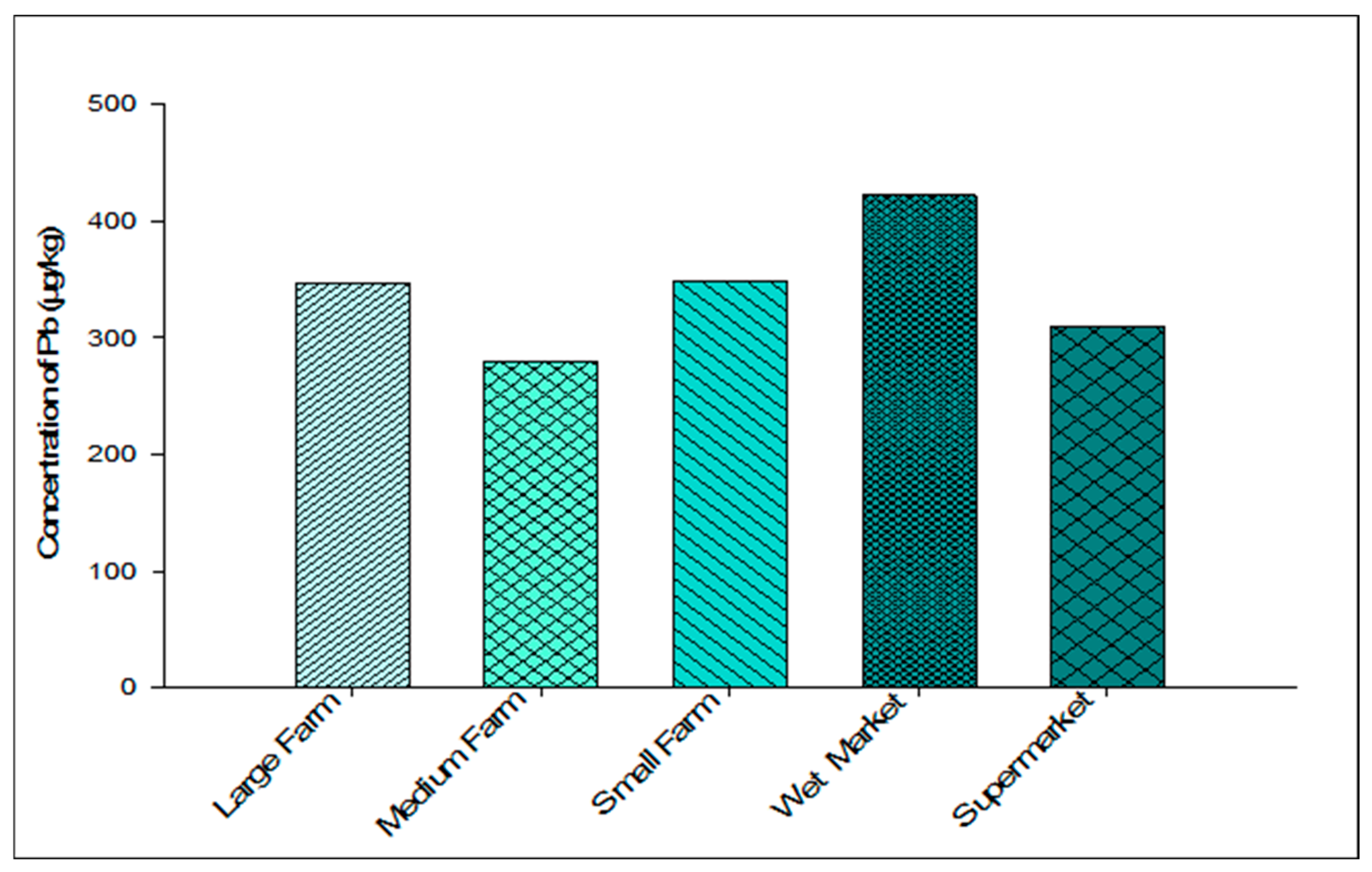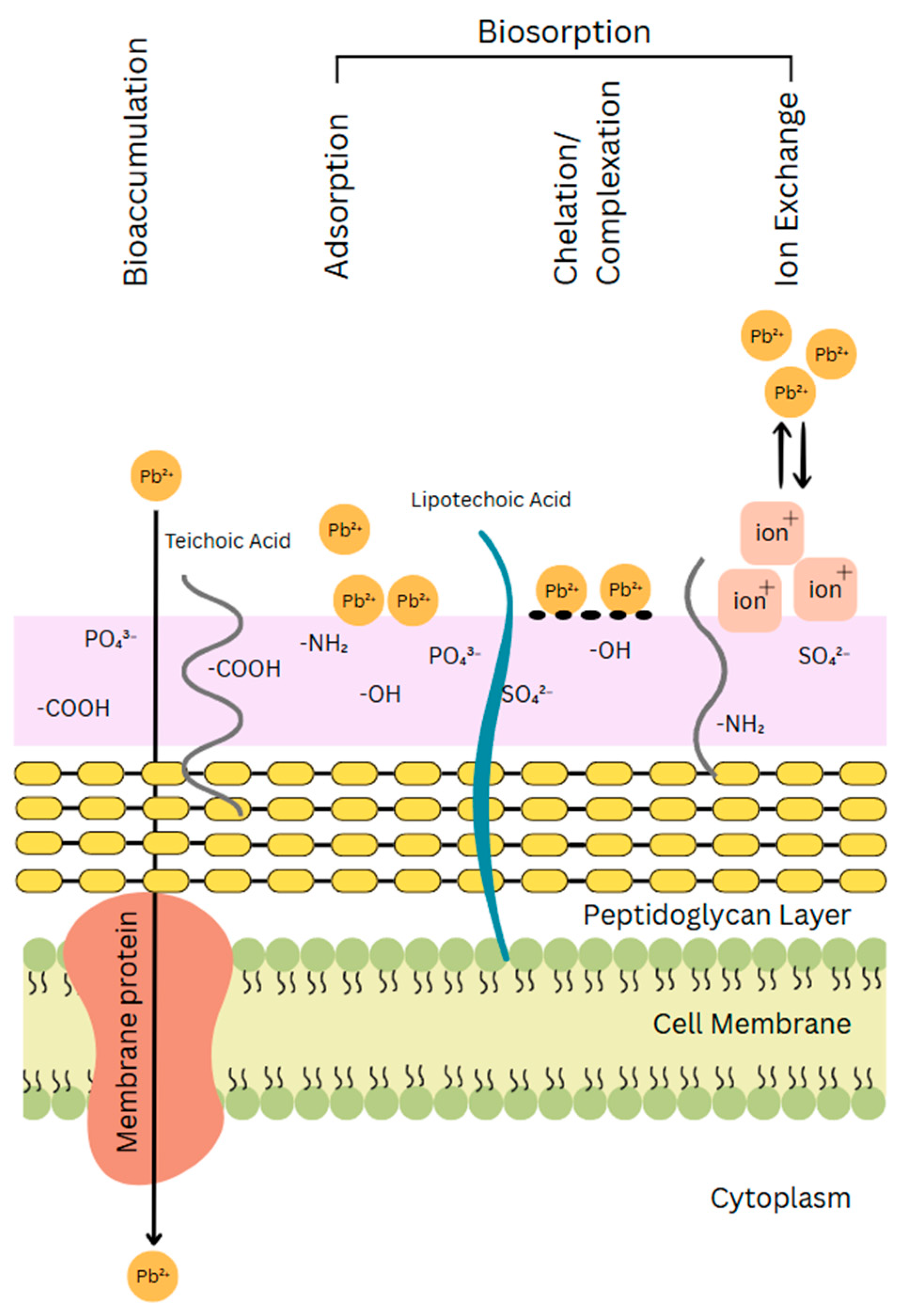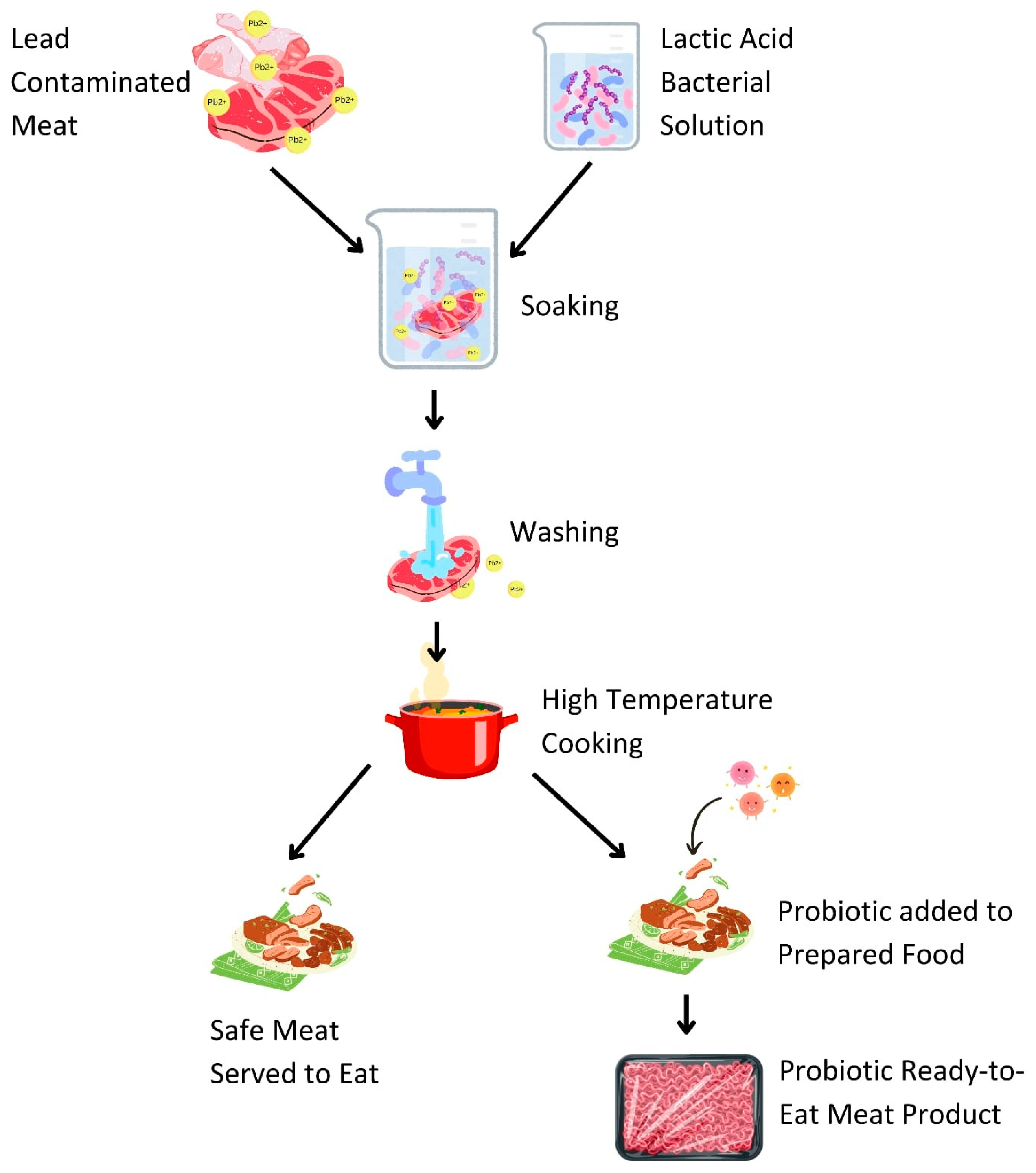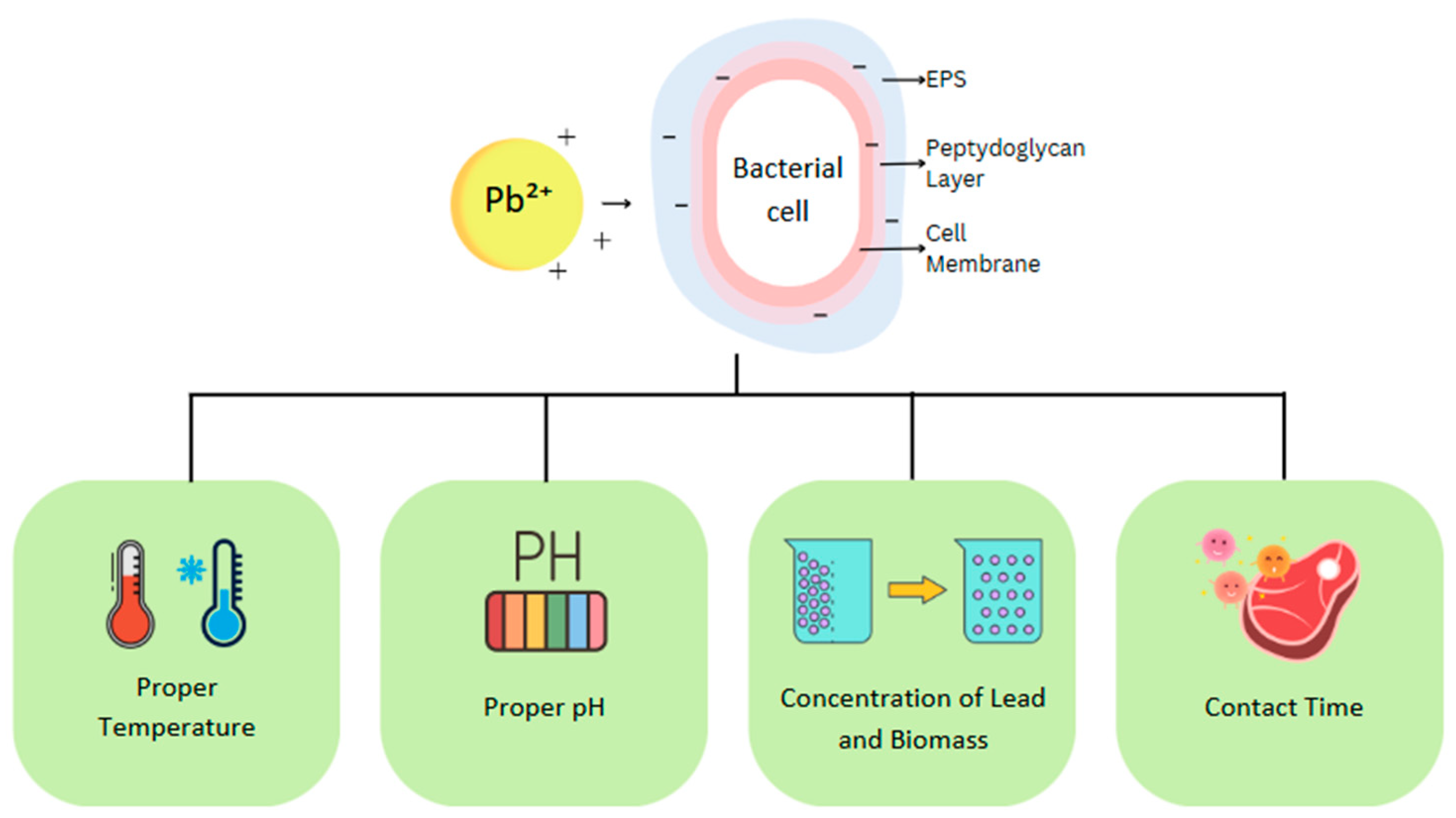Biological Approach for Lead (Pb) Removal from Meat and Meat Products in Bangladesh
Abstract
1. Introduction
2. Lead Contamination in Meat and Meat Products in Bangladesh
3. Prevalence of Probiotic Bacteria in Bangladesh and Their Lead (Pb) Removing Efficacy
4. Mechanisms of Heavy Metal Binding by LABs
5. Lead Removal from Meat Using Probiotics: A Strategic Approach
6. Optimizing the Parameters for the Hypothesized Treatment
7. Study Limitations and Future Plans
- ▪
- More research is required to optimize the parameters affecting the efficacy of the process in both in vivo and in vitro. This, however, might have economic constraints.
- ▪
- Contamination during storage and transportation is still not protected by this proposed method.
- ▪
- Biosorption of other heavy metals to the binding sites may lower the adherence of Pb2+ ions.
- ▪
- Although the methodology is backed up by in vitro scientific arguments, in vivo results might differ based on various factors. They thus cannot be implemented before proper animal and human testing.
8. Conclusions
Author Contributions
Funding
Data Availability Statement
Conflicts of Interest
References
- Angon, P.B.; Islam, M.S.; Das, A.; Anjum, N.; Poudel, A.; Suchi, S.A. Sources, effects and present perspectives of heavy metals contamination: Soil, plants and human food chain. Heliyon 2024, 10, e28357. [Google Scholar] [CrossRef]
- Zhang, H.; Lee, J.; Nasti, G.; Handy, R.; Abate, A.; Grätzel, M.; Park, N. Lead immobilization for environmentally sustainable perovskite solar cells. Nature 2023, 617, 687–695. [Google Scholar] [CrossRef]
- Collin, M.S.; Venkatraman, S.K.; Vijayakumar, N.; Kanimozhi, V.; Arbaaz, S.M.; Stacey, R.G.S.; Anusha, J.; Choudhary, R.; Lvov, V.; Tovar, G.I.; et al. Bioaccumulation of lead (Pb) and its effects on human: A review. J. Hazard. Mater. Adv. 2022, 7, 100094. [Google Scholar] [CrossRef]
- World Health Organization (WHO). Lead Poisoning. Available online: https://www.who.int/news-room/fact-sheets/detail/lead-poisoning-and-health (accessed on 5 February 2025).
- United Nations Children’s Fund (UNICEF). An Alarming Rate of Blood Lead Levels Among Children: UNICEF Urges the Interim Government to Implement a Strategy for a Lead-Free Bangladesh. Available online: https://www.unicef.org/bangladesh/en/press-releases/alarming-rate-blood-lead-levels-among-children-unicef-urges-interim-government (accessed on 17 March 2025).
- Majumder, A.K.; Nayeem, A.A.; Islam, M.; Akter, M.M.; Carter, W.S. Critical review of lead pollution in Bangladesh. J. Health Pollut. 2021, 11, 210902. [Google Scholar] [CrossRef] [PubMed]
- Ahmad, I.; Asad, U.; Maryam, L.; Masood, M.; Saeed, M.F.; Jamal, A.; Mubeen, M. Treatment methods for lead removal from wastewater. In Lead Toxicity: Challenges and Solution; Kumar, N., Jha, A.K., Eds.; Springer: Cham, Switzerland, 2023; pp. 197–226. [Google Scholar] [CrossRef]
- Patel, B.; Gundaliya, R.; Desai, B.; Shah, M.; Shingala, J.; Kaul, D.; Kandya, A. Groundwater arsenic contamination: Impacts on human health and agriculture, ex situ treatment techniques and alleviation. Environ. Geochem. Health 2022, 45, 1331–1358. [Google Scholar] [CrossRef]
- Toushik, S.H.; Mizan, M.F.R.; Hossain, M.I.; Ha, S.D. Fighting with old foes: The pledge of microbe-derived biological agents to defeat mono- and mixed-bacterial biofilms concerning food industries. Trends Food Sci. Technol. 2020, 99, 413–425. [Google Scholar] [CrossRef]
- Ashrafudoulla, M.; Park, J.; Toushik, S.H.; Shaila, S.; Ha, A.J.W.; Rahman, M.A.; Park, S.H.; Ha, S.D. Synergistic mechanism of UV-C and postbiotic of Leuconostoc mesenteroides (J. 27) combination to eradicate Salmonella Thompson biofilm in the poultry industry. Food Control 2024, 164, 110607. [Google Scholar] [CrossRef]
- Massoud, R.; Zoghi, A. Potential probiotic strains with heavy metals and mycotoxins bioremoval capacity for application in foodstuffs. J. Appl. Microbiol. 2022, 133, 1288–1307. [Google Scholar] [CrossRef]
- Mirza Alizadeh, A.; Hosseini, H.; Mohseni, M.; Mohammadi, M.; Hashempour-Baltork, F.; Hosseini, M.J.; Eskandari, S.; Sohrabvandi, S.; Aminzare, M. Bioremoval of lead (pb) salts from synbiotic milk by lactic acid bacteria. Sci. Rep. 2025, 15, 9101. [Google Scholar] [CrossRef]
- Firincă, C.; Zamfir, L.-G.; Constantin, M.; Răut, I.; Capră, L.; Popa, D.; Jinga, M.-L.; Baroi, A.M.; Fierăscu, R.C.; Corneli, N.O.; et al. Microbial removal of heavy metals from contaminated environments using metal-resistant indigenous strains. J. Xenobiot. 2023, 14, 51–78. [Google Scholar] [CrossRef]
- Giri, S.S.; Kim, H.J.; Jung, W.J.; Lee, S.B.; Joo, S.J.; Gupta, S.K.; Park, S.C. Probiotics in addressing heavy metal toxicities in fish farming: Current progress and perspective. Ecotoxicol. Environ. Saf. 2024, 282, 116755. [Google Scholar] [CrossRef] [PubMed]
- Lin, D.; Ji, R.; Wang, D.; Xiao, M.; Zhao, J.; Zou, J.; Li, Y.; Qin, T.; Xing, B.; Chen, Y.; et al. The research progress in mechanism and influence of biosorption between lactic acid bacteria and Pb(II): A review. Crit. Rev. Food Sci. Nutr. 2017, 59, 395–410. [Google Scholar] [CrossRef]
- Demirezen, D.; Uruç, K. Comparative study of trace elements in certain fish, meat, and meat products. Meat Sci. 2006, 74, 255–260. [Google Scholar] [CrossRef] [PubMed]
- Raeeszadeh, M.; Gravandi, H.; Akbari, A. Determination of some heavy metals levels in the meat of animal species (sheep, beef, turkey, and ostrich) and carcinogenic health risk assessment in Kurdistan province in the west of Iran. Environ. Sci. Pollut. Res. 2022, 29, 62248–62258. [Google Scholar] [CrossRef] [PubMed]
- González-Weller, D.; Karlsson, L.; Caballero, A.; Hernández, F.; Gutiérrez, A.; González-Iglesias, T.; Marino, M.; Hardisson, A. Lead and cadmium in meat and meat products consumed by the population in Tenerife Island, Spain. Food Addit. Contam. 2006, 23, 757–763. [Google Scholar] [CrossRef]
- Begum, R.; Akter, R.; Dang-Xuan, S.; Islam, S.; Siddiky, N.A.; Uddin, A.A.; Mahmud, A.; Sarker, M.S.; Grace, D.; Samad, M.A.; et al. Heavy metal contamination in retailed food in Bangladesh: A dietary public health risk assessment. Front. Sustain. Food Syst. 2023, 7, 1085809. [Google Scholar] [CrossRef]
- Lin, Y.C.; Chang, W.H.; Li, T.C.; Iwata, O.; Chen, H.L. Health risk of infants exposed to lead and mercury through breastfeeding. Expo. Health 2023, 15, 255–267. [Google Scholar] [CrossRef]
- Korish, M.A.; Attia, Y.A. Evaluation of heavy metal content in feed, litter, meat, meat products, liver, and table eggs of chickens. Animals 2020, 10, 727. [Google Scholar] [CrossRef]
- Syed, H. Assessing Lead in Milk and Environmental Samples Elicited from a Used Lead Acid Battery Separation Factory in Dinajpur District of Bangladesh. Doctoral Dissertation, Chattogram Veterinary & Animal Sciences University, Chittagong, Bangladesh, 2022. Available online: http://dspace.cvasu.ac.bd/bitstream/123456789/2496/1/THESIS%20%28MS%29%20Dr%20Syed%281%29.pdf%20final.pdf (accessed on 21 March 2025).
- Kumar, S.; Islam, R.; Akash, P.B.; Khan, M.H.R.; Proshad, R.; Karmoker, J.; MacFarlane, G.R. Lead (Pb) contamination in agricultural products and human health risk assessment in Bangladesh. Water Air Soil Pollut. 2022, 233, 257. [Google Scholar] [CrossRef]
- Shahriar, S.M.S.; Haque, N.; Hasan, T.; Sufal, M.T.A.; Hassan, M.T.; Hasan, M.; Salam, S.M.A. Heavy metal pollution in poultry feeds and broiler chickens in Bangladesh. Toxicol. Rep. 2025, 14, 101932. [Google Scholar] [CrossRef]
- Bokhtiar, S.M.; Islam, M.R.; Ahmed, M.J.; Rahman, A.; Rafiq, K. Assessment of heavy metals contamination and antimicrobial drugs residue in broiler edible tissues in Bangladesh. Antibiotics 2023, 12, 662. [Google Scholar] [CrossRef] [PubMed]
- Chowdhury, A.I.; Alam, M.R. Health effects of heavy metals in meat and poultry consumption in Noakhali, Bangladesh. Toxicol. Rep. 2024, 12, 168–177. [Google Scholar] [CrossRef]
- Hossain, M.M.; Hannan, A.S.M.A.; Kamal, M.M.; Hossain, M.A. Detection of heavy metals and evaluation of beef procured from the different market of Dhaka in Bangladesh. Eur. J. Food Sci. Technol. 2022, 10, 1–10. [Google Scholar] [CrossRef]
- Haque, M.N.; Islam, M.M.T.; Hassan, M.T.; Shekhar, H.U. Determination of heavy metal contents in frequently consumed fast foods of Bangladesh. Proc. Natl. Acad. Sci. India Sect. B Biol. Sci. 2018, 89, 543–549. [Google Scholar] [CrossRef]
- Toushik, S.H.; Kim, K.; Park, S.H.; Park, J.H.; Ashrafudoulla, M.; Ulrich, M.S.I.; Mizan, M.F.R.; Hossain, M.I.; Shim, W.B.; Kang, I.; et al. Prophylactic efficacy of Lactobacillus curvatus B67-derived postbiotic and quercetin, separately and combined, against Listeria monocytogenes and Salmonella enterica ser. Typhimurium on processed meat sausage. Meat Sci. 2023, 197, 109065. [Google Scholar] [CrossRef] [PubMed]
- Mirmahdi, R.S.; Zoghi, A.; Mohammadi, F.; Khosravi-Darani, K.; Jazaiery, S.; Mohammadi, R.; Rehman, Y. Biodecontamination of milk and dairy products by probiotics: Boon for bane. Ital. J. Food Sci. 2021, 33, 78–91. [Google Scholar] [CrossRef]
- Toushik, S.H.; Roy, A.; Alam, M.; Rahman, U.H.; Nath, N.K.; Nahar, S.; Matubber, B.; Uddin, M.J.; Roy, P.K. Pernicious attitude of microbial biofilms in agri-farm industries: Acquisitions and challenges of existing antibiofilm approaches. Microorganisms 2022, 10, 2348. [Google Scholar] [CrossRef] [PubMed]
- Zhang, Z.; Shu, G.; Zheng, Q.; Chen, L.; Du, G.; Zhang, M. Removal of cadmium, lead, and chromium by Lactobacillus helveticus KD-3: Influential factors, adsorption mechanism, and application in goat milk powder. LWT 2025, 117899. [Google Scholar] [CrossRef]
- Petrova, P.; Arsov, A.; Tsvetanova, F.; Parvanova-Mancheva, T.; Vasileva, E.; Tsigoriyna, L.; Petrov, K. The complex role of lactic acid bacteria in food detoxification. Nutrients 2022, 14, 2038. [Google Scholar] [CrossRef]
- Daisley, B.A.; Monachese, M.; Trinder, M.; Bisanz, J.E.; Chmiel, J.A.; Burton, J.P.; Reid, G. Immobilization of cadmium and lead by Lactobacillus rhamnosus GR-1 mitigates apical-to-basolateral heavy metal translocation in a Caco-2 model of the intestinal epithelium. Gut Microbes 2018, 10, 321–333. [Google Scholar] [CrossRef]
- Li, B.; Jin, D.; Yu, S.; Evivie, S.E.; Muhammad, Z.; Huo, G.; Liu, F. In vitro and in vivo evaluation of Lactobacillus delbrueckii subsp. bulgaricus KLDS1.0207 for the alleviative effect on lead toxicity. Nutrients 2017, 9, 845. [Google Scholar] [CrossRef] [PubMed]
- George, F.; Mahieux, S.; Daniel, C.; Titécat, M.; Beauval, N.; Houcke, I.; Neut, C.; Allorge, D.; Borges, F.; Jan, G.; et al. Assessment of Pb(II), Cd(II), and Al(III) removal capacity of bacteria from food and gut ecological niches: Insights into biodiversity to limit intestinal biodisponibility of toxic metals. Microorganisms 2021, 9, 456. [Google Scholar] [CrossRef] [PubMed]
- Azhar, U.; Ahmad, H.; Shafqat, H.; Babar, M.; Munir, H.M.S.; Sagir, M.; Arif, M.; Hassan, A.; Rachmadona, N.; Rajendran, S.; et al. Remediation techniques for elimination of heavy metal pollutants from soil: A review. Environ. Res. 2022, 214, 113918. [Google Scholar] [CrossRef]
- Sarker, A.; Kim, J.E.; Islam, A.R.M.T.; Bilal, M.; Rakib, M.R.J.; Nandi, R.; Rahman, M.M.; Islam, T. Heavy metals contamination and associated health risks in food webs—A review focuses on food safety and environmental sustainability in Bangladesh. Environ. Sci. Pollut. Res. 2022, 29, 3230–3245. [Google Scholar] [CrossRef] [PubMed]
- Toushik, S.H.; Kim, K.; Ashrafudoulla, M.; Mizan, M.F.R.; Roy, P.K.; Nahar, S.; Kim, Y.; Ha, S.D. Korean kimchi-derived lactic acid bacteria inhibit foodborne pathogenic biofilm growth on seafood and food processing surface materials. Food Control 2021, 129, 108276. [Google Scholar] [CrossRef]
- Kirillova, A.V.; Danilushkina, A.A.; Irisov, D.S.; Bruslik, N.L.; Fakhrullin, R.F.; Zakharov, Y.A.; Bukhmin, V.S.; Yarullina, D.R. Assessment of resistance and bioremediation ability of Lactobacillus strains to lead and cadmium. Int. J. Microbiol. 2017, 2017, 9869145. [Google Scholar] [CrossRef]
- Korcz, E.; Varga, L. Exopolysaccharides from lactic acid bacteria: Techno-functional application in the food industry. Trends Food Sci. Technol. 2021, 110, 375–384. [Google Scholar] [CrossRef]
- Sagmeister, T.; Gubensäk, N.; Buhlheller, C.; Grininger, C.; Eder, M.; Ðordić, A.; Millán, C.; Medina, A.; Murcia, P.A.S.; Berni, F.; et al. The molecular architecture of Lactobacillus S-layer: Assembly and attachment to teichoic acids. Proc. Natl. Acad. Sci. USA 2024, 121, e2401686121. [Google Scholar] [CrossRef]
- Mostafidi, M.; Sanjabi, M.R.; Mojgani, N.; Eskandari, S.; Bidgoli, S.A. Heavy metal bioremediation potential of autochthonous lactic acid bacteria for use in edible leafy vegetables. J. Food Qual. 2023, 1, 8730676. [Google Scholar] [CrossRef]
- Chapot-Chartier, M.; Kulakauskas, S. Cell wall structure and function in lactic acid bacteria. Microb. Cell Fact. 2014, 13, S9. [Google Scholar] [CrossRef]
- Xu, Y.; Shu, G.; Liu, Z.; Wang, Z.; Lei, H.; Zheng, Q.; Kang, H.; Chen, L. Preliminary Study on Screening and Genetic Characterization of Lactic Acid Bacteria Strains with Cadmium, Lead, and Chromium Removal Potentials. Fermentation 2024, 10, 41. [Google Scholar] [CrossRef]
- Wang, Y.; Han, J.; Ren, Q.; Liu, Z.; Zhang, X.; Wu, Z. The involvement of lactic acid bacteria and their exopolysaccharides in the biosorption and detoxification of heavy metals in the gut. Biol. Trace Elem. Res. 2023, 202, 671–684. [Google Scholar] [CrossRef]
- Tian, F.; Zhai, Q.; Zhao, J.; Liu, X.; Wang, G.; Zhang, H.; Zhang, H.; Chen, W. Lactobacillus plantarum CCFM8661 alleviates lead toxicity in mice. Biol. Trace Elem. Res. 2012, 150, 264–271. [Google Scholar] [CrossRef]
- Elsanhoty, R.M.; Al-Turki, I.A.; Ramadan, M.F. Application of lactic acid bacteria in removing heavy metals and aflatoxin B1 from contaminated water. Water Sci. Technol. 2016, 74, 625–638. [Google Scholar] [CrossRef] [PubMed]
- Liu, G.; Geng, W.; Wu, Y.; Zhang, Y.; Chen, H.; Li, M.; Cao, Y. Biosorption of lead ion by lactic acid bacteria and the application in wastewater. Arch. Microbiol. 2023, 206, 18. [Google Scholar] [CrossRef]
- Mohammadi, F.; Marti, A.; Nayebzadeh, K.; Hosseini, S.M.; Tajdar-Oranj, B.; Jazaeri, S. Effect of washing, soaking and pH in combination with ultrasound on enzymatic rancidity, phytic acid, heavy metals and coliforms of rice bran. Food Chem. 2020, 334, 127583. [Google Scholar] [CrossRef] [PubMed]
- Raman, J.; Kim, J.S.; Choi, K.R.; Eun, H.; Yang, D.; Ko, Y.J.; Kim, S.J. Application of lactic acid bacteria (LAB) in sustainable agriculture: Advantages and limitations. Int. J. Mol. Sci. 2022, 23, 7784. [Google Scholar] [CrossRef]
- Trisnawita, Y.; Silalahi, J.; Sinaga, S.M. The effect of storage condition on viability of lactic acid bacteria in probiotic product. Asian J. Pharm. Clin. Res. 2018, 11, 84. [Google Scholar] [CrossRef][Green Version]
- Abdelshafy, A.M.; Mahmoud, A.R.; Abdelrahman, T.M.; Mustafa, M.A.; Atta, O.M.; Abdelmegiud, M.H.; Al-Asmari, F. Biodegradation of chemical contamination by lactic acid bacteria: A biological tool for food safety. Food Chem. 2024, 460, 140732. [Google Scholar] [CrossRef]
- Li, W.; Chen, Y.; Wang, T. Cadmium biosorption by lactic acid bacteria Weissella viridescens ZY-6. Food Control 2020, 123, 107747. [Google Scholar] [CrossRef]
- Jena, P.S.; Pradhan, A.; Nanda, S.P.; Dash, A.K.; Naik, B. Biosorption of heavy metals from wastewater using Saccharomyces cerevisiae as a biosorbent: A mini review. Mater. Today Proc. 2022, 67, 1140–1146. [Google Scholar] [CrossRef]
- Massoud, R.; Khosravi-Darani, K.; Sharifan, A.; Asadi, G.; Zoghi, A. Lead and cadmium biosorption from milk by Lactobacillus acidophilus ATCC 4356. Food Sci. Nutr. 2020, 8, 5284–5291. [Google Scholar] [CrossRef] [PubMed]
- Ma, X. Heavy metals remediation through lactic acid bacteria: Current status and future prospects. Sci. Total Environ. 2024, 946, 174455. [Google Scholar] [CrossRef]
- Kumar, V.; Dwivedi, S.K. Mycoremediation of heavy metals: Processes, mechanisms, and affecting factors. Environ. Sci. Pollut. Res. 2021, 28, 10375–10412. [Google Scholar] [CrossRef] [PubMed]







| Lactic Acid Bacteria (LAB) | Lead (Pb) Removal Ability * | Reference |
|---|---|---|
| Lactobacillus acidophilus DSM 20079 | Moderate | [36] |
| Lb. acidophilus NCFM | Low | [36] |
| Pediococcus pentosaceus | Moderate | [30] |
| Bifidobacterium longum FPL 19312 | Weak | [36] |
| B. longum Morinaga | Low | [36] |
| Lactiplantibacillus plantarum LAB-32 | High | [33] |
| Lp. plantarum PTCC 1896 | Moderate | [33] |
| Lactobacillus rhamnosus ATCC 9595 | Moderate | [36] |
| Lb. rhamnosus ATCC 53103 (GG) | Low | [36] |
| Lb. rhamnosus Lr-32 | Moderate | [36] |
| Lb. rhamnosus FPL 19125 | Moderate | [36] |
| Lactobacillus delbrueckii DSM 20081 | High | [36] |
| Limosilactobacillus fermentum DSM 20055 | High | [36] |
| Lactobacillus fermentum FPL 19124 | High | [36] |
| Lactobacillus farciminis DSM 20184 | High | [36] |
| Lactobacillus casei DSM 20011 | Moderate | [36] |
| Lb. casei BL23 | Low | [36] |
| Leuconostoc mesenteroides DSM 20343 | High | [36] |
| Levilactobacillus brevis DSM 20054 | High | [36] |
| Lactococcus lactis MG1363 | Weak | [36] |
| Weissella confusa DSM 20196 | High | [36] |
| Lactobacillus farciminis DSM 20184 | High | [36] |
Disclaimer/Publisher’s Note: The statements, opinions and data contained in all publications are solely those of the individual author(s) and contributor(s) and not of MDPI and/or the editor(s). MDPI and/or the editor(s) disclaim responsibility for any injury to people or property resulting from any ideas, methods, instructions or products referred to in the content. |
© 2025 by the authors. Licensee MDPI, Basel, Switzerland. This article is an open access article distributed under the terms and conditions of the Creative Commons Attribution (CC BY) license (https://creativecommons.org/licenses/by/4.0/).
Share and Cite
Maisa, N.S.; Hoque, S.B.; Toushik, S.H. Biological Approach for Lead (Pb) Removal from Meat and Meat Products in Bangladesh. Processes 2025, 13, 2018. https://doi.org/10.3390/pr13072018
Maisa NS, Hoque SB, Toushik SH. Biological Approach for Lead (Pb) Removal from Meat and Meat Products in Bangladesh. Processes. 2025; 13(7):2018. https://doi.org/10.3390/pr13072018
Chicago/Turabian StyleMaisa, Nowshin Sharmily, Sumaya Binte Hoque, and Sazzad Hossen Toushik. 2025. "Biological Approach for Lead (Pb) Removal from Meat and Meat Products in Bangladesh" Processes 13, no. 7: 2018. https://doi.org/10.3390/pr13072018
APA StyleMaisa, N. S., Hoque, S. B., & Toushik, S. H. (2025). Biological Approach for Lead (Pb) Removal from Meat and Meat Products in Bangladesh. Processes, 13(7), 2018. https://doi.org/10.3390/pr13072018







